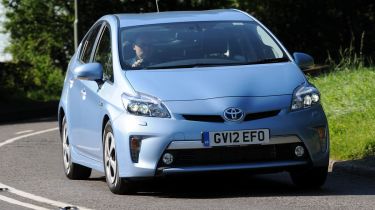Toyota Prius Plug-in
The Toyota Prius Plug-in offers staggering fuel economy, but is it worth the premium over a regular Prius?

The Prius Plug-in is an excellent all-round eco car, with space, practicality and outstanding fuel consumption. It takes advantage of its EV capabilities to make an excellent short-distance commuter, yet because it's a hybrid, you don't have to suffer from range anxiety. It shares the regular Prius' bland driving experience, but in the name of economy, it's an outstanding real-world eco car.
Is this the best Toyota Prius on sale? The all-new Plug-in version promises greater economy, as its more efficient batteries give an even longer electric-only range. The car is Toyota’s answer to range-extenders like the Vauxhall Ampera and Chevrolet Volt – and it undercuts them, too, at £27,895 after the £5,000 Government EV grant (the Ampera costs £33,995 after the same discount).
On the outside, this Prius looks like any other, with only minor touches like the chrome front bumper details, silver number plate shroud on the bootlid and badging setting it apart. But under the skin, new lithium-ion batteries replace the regular nickel versions, and they take the electric-only range from around two miles to 15 miles.
After testing 600 plug-in research vehicles in Europe over the past few years, Toyota found that most had an average daily journey of 12.5 miles – so the Prius Plug-in should be able to complete most commutes on electric power. It takes just 90 minutes to charge, and this can be done at a regular socket. But if the battery runs flat, the Plug-in behaves like a regular Prius, running on petrol power, so there’s no range anxiety.
Used - available now

2018 Toyota
Prius
26,136 milesAutomaticPetrol1.8L
Cash £12,495
2020 Toyota
Prius
50,351 milesAutomaticPetrol1.8L
Cash £17,700
2020 Toyota
Prius
44,951 milesAutomaticPetrol1.8L
Cash £19,909
2018 Toyota
Prius
52,000 milesAutomaticPetrol1.8L
Cash £12,500Due to the batteries’ greater range, however, the petrol engine – which is the same 1.8-litre as used in the Prius – doesn’t have to cut in as often, and won’t use as much fuel. Toyota claims a staggering economy figure of 134.5mpg, backed up by CO2 emissions of 49g/km. The Prius’ 72mpg and 89g/km suddenly don’t look quite so impressive.
But all this comes at a cost: the batteries add 50kg of weight to the package and 0.9 seconds to the 0-62mph time, taking the latter to 11.3 seconds. There’s also the price: the standard Prius range kicks off at £21,600, which is a massive £6,295 cheaper. Still, the £27,895 Prius Plug-in is based on the top- spec T Spirit, so you get plenty of kit for the money, including sat-nav, Bluetooth, a head-up display, JBL stereo and leather seats.
The driving experience is near-identical, too. You can switch between full EV and hybrid modes, an EV City setting – which requires a more forceful right foot to get the petrol engine to cut in – and an Eco mode that makes the throttle softer to conserve energy.
The steering is accurate and light, the ride comfortable (even though it thumps a bit over bumps) and overall the Prius is easy to drive. The only real negative is the drone from the engine due to the CVT gearbox, but that’s the same with the regular car.
The big question is whether the Plug-in is worth the extra? You’ll have to do your sums. If you do frequent short trips, you’ll hardly spend anything on petrol. Plus, drivers will benefit from the likely drop in the threshold for road tax exemption from 99g/km to 85g/km, and those in London will be able to cash in when the Congestion Charge threshold falls to 80g/km at the end of this year. Outside the capital, however, you’re probably still better off with the regular Prius.







